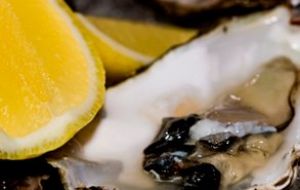MercoPress. South Atlantic News Agency
Viral epidemic for third year in a row ravages French oyster farms
 The full impact of the oyster depletion will be felt this Christmas
The full impact of the oyster depletion will be felt this Christmas French oyster-growers are facing ruin because of a viral epidemic that for a third year in a row has been wiping out millions of baby shellfish. From the Mediterranean coast to the bay of Arcachon on the Atlantic and now Brittany, farmers have been watching in dismay in recent weeks as the virus once again moved northwards, keeping pace with the rising sea temperature.
In 2008 and 2009, the industry was ravaged by the same epidemic, with many farms losing 80-100% of their stocks of naissains - first-year spats. Because it takes three years to grow a commercially viable oyster, so far the economic impact of the crisis has been limited.
But now all pre-2008 production has been depleted, so major shortages are predicted next winter when demand peaks around Christmas and New Year. In France that is when some 90% of oysters are sold.
The Committee to Save Oyster-Farming - an ad-hoc group set up in answer to the crisis - has warned that 40% of the country's 4,800 mainly family-run businesses could be forced to close, with the loss of thousands of jobs.
The state marine research agency (Ifremer) said it is “one of the worst crises in the history of French oyster-farming”. Last month hundreds of farmers staged a much-publicised protest in central Paris, dumping lorry-loads of oyster-shells on one of the Seine river bridges.
Their pressure paid off, because the French government has now promised a 150 million Euro rescue package to tide the industry through the next three years. This is not the first time the oyster business has been in crisis, but it is the first time the crisis has been man-made
Low-tide on the sand flats at Le Po, a hamlet near Carnac in southern Brittany, exposes the poches or bags of oysters being cultivated by Bruno Lemoine. Last week he detected the first signs of the epidemic, with many of the inch-long molluscs lying open and empty.
”The sea here has just reached 17C (62.6F), which is the temperature when the virus hits. In a week or two I predict that 70% of these naissains will be dead. We are in real trouble,“ he said.
Scientists have no difficulty identifying the cause of the hecatomb. It is a strain of herpes virus designated OsHV-1, which is often accompanied by a bacterium called Vibrio splendidus.
The OsHV-1 virus has been around for millions of years, attacking oysters in the wild. But now oysters are being mass-produced, and in conditions which many believe have encouraged the virus to spread.
”This is not the first time the oyster business has been in crisis, but it is the first time the crisis has been man-made,“ said Francois Gouzer, whose business at Saint-Philibert has been in the family for three generations.
At issue are the hatcheries - mainly based further south on the Atlantic coast - where in the past five years oyster eggs have been produced by the million with a main eye on the profit margin. The oyster larvae are then transferred elsewhere on the French coast for further cultivation.
Some 80% of hatchery shellfish are so-called ”triploid“ sterile oysters that have been specially developed for the market.
With an extra pair of chromosomes these oysters grow more quickly than conventional ”diploids“, and do not develop the milky substance that makes ordinary oysters un-sellable in the summer months.
”Unofficially everyone thinks the hatcheries are to blame, even if no-one says so openly,“ says Jacques Cadoret, one of the biggest producers in the country. ”Certain sorcerers' apprentices have been playing games in their labs, trying to get oyster eggs by unnatural means.“
At Ifremer, scientists say that triploid oysters cannot alone explain the spread of the virus because they have not been noticeably worse hit than diploids. They also point out that many of those complaining about hatcheries today were the first to urge their creation in order to boost production.
However, they concede that intensive farming methods may be a factor in the current crisis.
”It is true that in recent years production of oysters in France has been absolutely colossal. Certain practices may have been developed that have weakened the species, and made it more susceptible to disease,“ says Nathalie Cochennec, in charge of tracking the virus at Ifremer.
According to Ms Cochennec, the best hope now is for scientists to breed new strains of the oyster that will prove resistant to the disease. The risk is that this policy could take many years to come to fruition.
Older hands need no reminding of the fragility of oyster farming. In France cultivation dates only from the mid 19th Century, but twice since then entire species have been wiped out by disease: first in the 1920s and then again in 1970.
Today's species - the Pacific oyster or Crassostrea Gigas - has only been cultivated in France for some 40 years.
”There used to be a saying among oyster-farmers - always be ready to move,“ says Francois Cadoret, now in his 80s, whose family has raised oysters at Locmariacquer since 1870. ”People forget it's a most unreliable business” (BBC).-




Top Comments
Disclaimer & comment rulesCommenting for this story is now closed.
If you have a Facebook account, become a fan and comment on our Facebook Page!